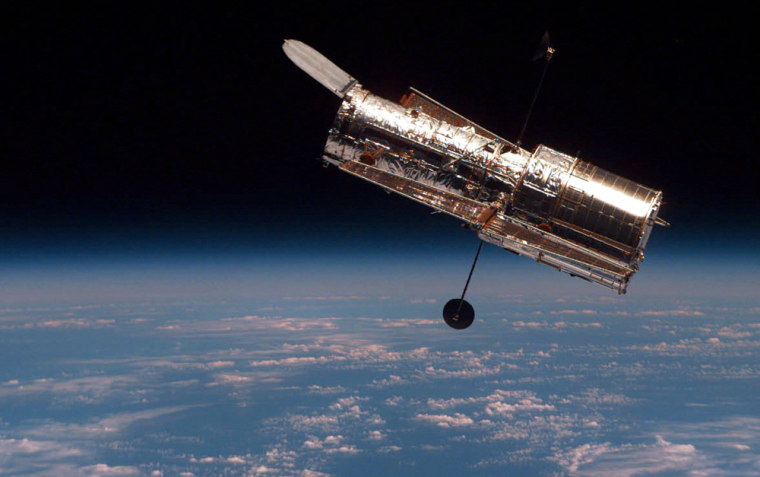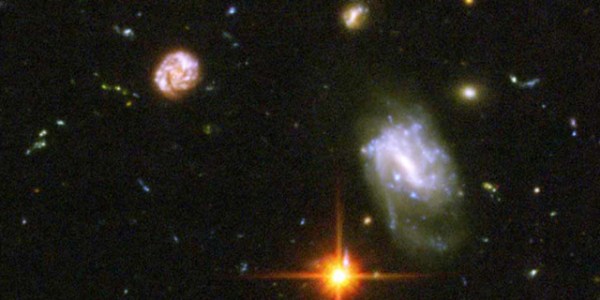When it comes to fixing up the Hubble Space Telescope, is the best person for a job actually a robot? A report being submitted to NASA this week casts doubt on that proposition, contending a robotic repair mission would be costlier and riskier than the space agency thinks.
In response, experts familiar with the Hubble rescue plan being developed at NASA’s Goddard Space Flight Center say that the report overestimates the obstacles. They insist that planners already have a firm foundation in place for sending a robot to do an astronaut’s job and point out that the study assumed a mission that started from scratch, which they are not doing.
At issue is what sort of new hardware needs to be developed soon to prolong the life of Hubble in the absence of a previously-scheduled space shuttle servicing mission. That flight was cancelled last January when NASA officials decided that the chance of a repeat of the Columbia disaster was too high. Unlike missions to the space station, a crew sent to the Hubble would have nowhere to wait for a rescue mission should one be necessary.
Time running out
NASA originally intended to cease repairs to Hubble entirely. Public outcry in support of the popular telescope instead led NASA to begin planning a robotic mission to Hubble, to perform as many of the human-tended servicing tasks as possible.
The agency also commissioned an outside report to look at all possible options and it is this report, by private space consultants Aerospace Corporation, that is being submitted to NASA this week.
According to an executive summary obtained by MSNBC.com, the report concludes that robotic missions are too challenging given the time remaining until the telescope’s systems begin failing.
The study, titled “Hubble Space Telescope Servicing – Analysis of Alternatives,” says that robotic missions would cost too much ($2 billion or more), take too long, and still have less than half a chance of working even after all the time and money (and delays to follow-on programs) had been expended.
Other approaches, such as sending up a "safe haven" module to orbit near Hubble and then sending up a shuttle crew, are also offered in the report. The study also considers missions ranging from no action at all, to de-orbit only, to the entire spectrum of repair by robots. It also evaluates moving new instruments intended for Hubble onto other satellites.
A public affairs official at Aerospace Corporation declined to comment on the details of the report, noting that it was up to NASA whether the report was publicly released.
Defending the robots
A NASA official involved with the current robot repair effort pointed out that the pricing models used by the Aerospace Corporation were only accurate for assessing the full life of a project that starts from scratch, but are not easily adaptable to picking something up that already exists.
The official, who requested his name not be used, said that the Goddard project uses "an existing space station robot, modified. We take the existing hardware, improve it regarding detection sensors and so forth, and go on from there.”
The official also insisted that the robotics team as constituted was a break from current models of the NASA bureaucracy. “This is NASA in transition, from a quasi-steady operational system, to NASA as an R&D high-risk exploratory mode – back to the Apollo mode.”
“This can only be done in the pathfinder fast-track approach” with rapid mission development, he said. “It avoids much of the traditional bureaucracy.”
This management approach has worked well when it has occasionally been tried in the past, the Goddard official, referring to a crash project to repair a solar observing satellite in 1984 and, a decade later, the crash project to repair the Hubble’s faulty optical system. He expects this non-bureaucratic approach to be a model of how NASA will implement the White House’s exploration agenda and avoid the high cost estimates for start-from-scratch spacecraft development for sending astronauts back to the Moon.
“It’s utilization of existing technology and hardware, this is the big difference,” he repeated. “We are not starting from scratch.”
The official also said that estimates of cost and schedule were realistic. Current plans are to spend $1.3 billion and launch in December 2007, and the project currently is about two weeks ahead of a schedule drawn up last summer.
That price tag includes the cost of a de-orbit module that will be used to dump the telescope safely into an ocean once the instruments have ceased functioning in seven or eight years. Without such a deliberate suicide plunge, the massive telescope’s fragments have a 1 in 250 chance of hurting somebody on Earth -– far more hazardous than the 1 in 10,000 chance that NASA standards require.
“We’re working weekends,” the official said. “We are in partnership with the best people around the world. They sign on, they know it’s Saturdays and Sundays, they have to be there, make the personal sacrifices.”
“This is the pathfinder, a test of ways to do other kinds of missions,” he said. “This is the NASA not afraid to step out and take risks, the new things we need to do exploration.”

